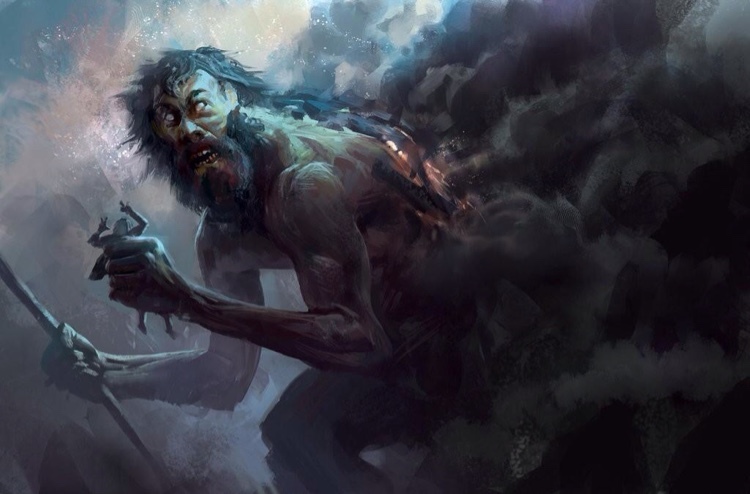ASH AND RUDRAKSHA
 |
| Aghori smeared in ash (Vibhuti ) |
In Sanskrit, Bhoothi means Aishwaryam(fame),further translating into wealth, treasure(spiritual and worldly). Vi-bhoothi with an Upasarga (preposition "vi") means very or more valuable. The synonyms of Vibhuhti in Sanskrit as said in the Amara-kosha is "Vibhuthi: bhoothi: Aishwaryam". Vibhuhti exhibits transcendence. Those who wear vibhuti need not wear anything else. Lord Shiva is said to wear Vibhuti all over his body signifying insulation from all existence but at the same time being surrounded by it and in knowledge and control of it. Of the Hindu trinity, the three aspects of divine, Shiva is the only GOD who has chosen his abode on earth in his all encompassing form which is perceived by his ardent devotees. He is also the only deity accessible by mortals on a physical plane of existence among the trinity. GOD Shiva is worshiped by all beings as he is an incarnation of Mahadev, the male form of Supreme soul, Brahman.
 |
| Om Namah Shivaya |
Bhasma is specially associated with Lord Shiva, who applies it all over His body. According to Hindu legends Vibhuti or Bhasma is said to be favorite to Lord Shiva and that's why He is often called Vibhuti Bhushan (the one having ash as his ornament). Shiva devotees apply bhasma as a tripundra (the form of three lines).
Ash is what remains when all the wood is burnt away and it does not decay. Similarly, the Lord is imperishable Truth that remains when the entire creation of innumerable names and forms is dissolved by him.
Bhasma is believed to have medicinal value and is used in many ayurvedic medicines. It absorbs excess moisture from the body and prevents colds and headaches. The Upanishads say that the famous Mrityunjaya mantra should be chanted whilst applying ash on the forehead, thus:
- “Om Tryambakam yajaamahe sugandhim pushtivardhanam Urvaarukamiva bandhanat mrutyor muksheeya maamritaat !!”
- “We worship the three-eyed God Shiva who nourishes and spreads fragrance in our lives. May He free us from the shackles of sorrow, change and death effortlessly, like the fall of a ripe cucumber from its stem !!”
In yajna, vibhuti is considered very sacred, Agni (lord of fire) who conveys the offerings during invocations, to the respective deity, the remainder of which is a partake, sharing with the aspect of divine. The residue left over which is off white in color is considered as vibhuthi and is given to the devotees as an offering for daily use to please Lord Shiva.
"Suta then goes on he explain the greatness of Shiva's name and the importance of Bhasma (ash) and rudraksha beads in his worship. The name of Shiva is as sacred as Ganges. Similarly 'Bhasma' and 'Rudraksha' are as holy as the rivers Yamuna and Saraswati. Therefore a devotee who possesses the name of lord Shiva on his lips, who applies Bhasma on his person and who wears a rudraksha in his neck attain the virtues similar to that of taking a bath in the sangam. In ancient times, a king by the name of Indrayumna got liberated from the bondages of the world, just by chanting the name of Shiva." --- SHIVA PURANA
 |
| Aghori Sadhus wearing ash |
THE IMPORTANCE OF BHASMA (ASH) IN SHIVA'S WORSHIP
Swami Nalanda:" Bhasma ( Ash ) is what that is left when we set fire to anything. Its the end of an individual's physical and material body in that particular birth. The body is made of the five basic elements - Fire, water, sand, Metal and Air. When the body is burned we get Ash, which is the mixture of the five major elements. Bhasma is also said to posses quick healing power. "
Bhasma are of two types:-1) Maha Bhasma and 2) Swalpa Bhasma.
'Shrota' (listener), 'Smart; (rites according to the smritis) and Laukik (worldly) are considered to be the Maha Bhasma. There are many types of Swalpa Bhasma.
'Shrota' and 'Smart' are meant only for the brahmins. For the rest of the castes, 'Laukik Bhasma' is appropriate. A brahmin must apply Bhasma, only after initiating it with the mantras. The ashes
which remains after burning dry cowdung is called Agneya Bhasma. Applying 'Tripunda' on the forehead with the ashes after the completion of Yagya, is to the Upanishad rituals like Sandhya and Japa should only be performed after applying tripunda on the forehead.
 |
| God Shiva( Mohit in Tv series) wearing Rudraksha and Ash |
GOD Shiva then went on to describe the purity of ash and said---Ash is extremely pure, as it is the residual element of matter, which is left after burning. It is sacred and indestructible. This is why I smear it on my body. A person who smears ash on his body becomes liberated from all his sins. It is the destroyer of sin.- Shiva Purana
IMPORTANCE OF RUDRAKSHA
Rudraksha is very dear to lord Shiva and hence all the sins of a man get destroyed if he chants the name of Lord Shiva using a Rudraksha beads. He also attains salvation after his death. It is believed that the origin of Rudraksha is connected with Shiva penance.
Once while Sadashiv was performing his penance, his eyes opened due to some disturbances. He was so remorseful that tears rolled down from his eyes. These tear-drops are believed to be the origin of the Rudraksha trees.
Rudraksha of specific colours have been prescribed for different castes. For example a Brahmin, a Kshatriya, a Vaishya and a Shudra have been instructed to put on Rudraksha of white colour, red colour, yellow colour and black colour respectively.
Swami Nalanda: "Rudrakha chains are made out of seeds of Rudraksha. Seeds donot die like " Atma" or soul and soul is one that gives life and so does a seed. Wearing ash and Rudraskha on his body ...IS THE IDEAL MARK OF A SHAIVAN"
 |
| Swami Nalanda |




Comments
Post a Comment